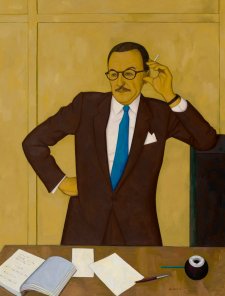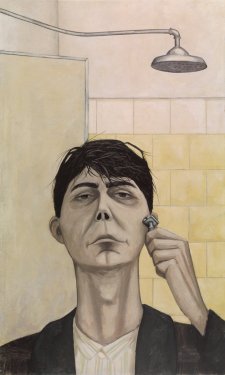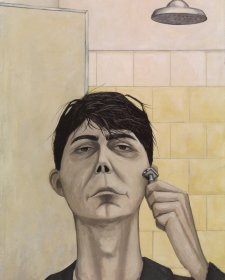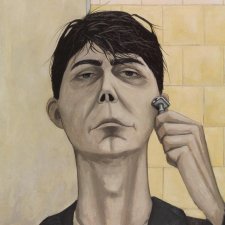- About us
- Support the Gallery
- Venue hire
- Publications
- Research library
- Organisation chart
- Employment
- Contact us
- Make a booking
- Onsite programs
- Online programs
- School visit information
- Learning resources
- Little Darlings
- Professional learning
John Brack (1920-1999), artist, grew up in Melbourne and studied at the National Gallery School at night while working as a junior insurance clerk. After war service he resumed his studies, and in 1949 secured a job in the National Gallery of Victoria’s Print Room, where he worked until 1951, leaving to take up the position of art master at Melbourne Grammar School. His paintings succeeded immediately; his first exhibited work, Barber’s Shop, was purchased for the NGV in 1953 as was Collins Street, 5p.m. three years later. In 1962 he became Head of the National Gallery Art School. Six years later, finally confident that he could make a living as a full-time artist, he resigned. He painted shopfronts, school yards, gardens and housing estates, nudes, office workers, ballroom dancers, jockeys, brides, drinkers, commissioned portraits and portraits of friends and family. In recent years The Bar 1954 and The Old Time 1969 have set new auction records for the sale of Australian paintings. Brack painted 35 portraits in oils. The brilliant double portrait with which he is pictured here is his largest and most ambitious; Patrick McCaughey wrote to him ‘It is a remarkable achievement to pull of the double portrait in 1978 – what an argument it makes for your “stubbornness”!’
Alexander George Mitchell (1911-1997), academic, studied English literature and language at the University of Sydney and the University of London before joining the English department of the University of Sydney, where he assumed the McCaughey Chair of Early English Literature and Language in 1947. In 1961 he became deputy vice-chancellor. Mitchell’s research into Australian English was profoundly influential, demonstrating that the speech of Australians had its own history, legitimately distinct from ‘Standard English’ or ‘Received Pronunciation’ of which, until then, it had been deemed an undesirable corruption. His books included The Pronunciation of English in Australia (1946, and revised edition 1957 with Arthur Delbridge), The Use of English (1954) and The Speech of Australian Adolescents (with Delbridge, 1965).A member of the interim council charged with planning a third university for Sydney - Macquarie University - and later vice-chair of that university’s first council, Mitchell became Macquarie’s foundation Vice-Chancellor in 1965.Mitchell saw the university grow exponentially and championed its innovative character, which fostered a broad liberal education through large multidisciplinary schools and engagement with industry, commerce and the community. He oversaw the establishment of the groundbreaking Social Sciences Resource Centre in 1974. Although he was never one of its editors, his interest in Australian English is credited with having informed the development of the Macquarie Dictionary, first published in 1981 and revised for several editions since.
The Rt Hon Sir Garfield Barwick AK GCMG KC (1903–97), Chief Justice of Australia from 27 April 1964 to 11 February 1981, was the longest serving Chief Justice of Australia. Barwick grew up in impoverished circumstances in the then-slum suburb of Stanmore in Sydney, but gained a scholarship to Fort Street School and took the University Medal in Law at the University of Sydney. Admitted to the bar in 1927, appointed King’s Counsel in 1941 and taking silk in 1942, he came to public attention as the prosecuting attorney in the Dobell case. During the war he defended various businesses against wartime regulations, opposing attorney general ‘Doc’ Evatt (who called him ‘Bushy Tail’) and becoming a regular before the Privy Council. Later he was Menzies’s choice to advocate the banning of the Communist Party, and he represented ASIO in the Petrov Royal Commission in 1954. In 1958 he was elected Liberal member for Parramatta; he was Attorney-General from 1958 to 1961, and Minister for External Affairs from 1961 to 1964, during which period Gough Whitlam was named in Parliament for calling him a ‘truculent runt’. In 1964 he left parliament, and was appointed a Privy Counsellor; he served as Chief Justice for the next 17 years. In this capacity he provided official advice to his friend John Kerr, confirming the legality of the Dismissal. Barwick was Chancellor of Macquarie University from 1967 to 1978; during this period he took an active interest in the design and construction of the High Court building – accordingly dubbed ‘Gar’s Mahal’ - which opened in Canberra in 1980. David Marr’s hostile biography, Barwick – his first book - was published that year. In retirement Barwick wrote Sir John Did His Duty (1983) and a personal ‘apologia’, Radical Tory (1995).
Gift of the Jozef Vissel 2015
© Jozef Vissel
Jozef Vissel (age 42 in 1977)
The Rt. Hon Sir Garfield Barwick AK GCMG QC (age 74 in 1977)
Alex Mitchell (age 66 in 1977)
John Brack (age 57 in 1977)
Jozef Vissel (13 portraits)



On one level The Companion talks about the most famous and frontline Australians, but on another it tells us about ourselves.



Australian Galleries Director Stuart Purves tells the story of two portraits by John Brack.



Dr Sarah Engledow explores the early life and career of John Brack.